|
https://www.youtube.com/embed/GLYoNNfnGHs
3D Printing News Unpeeled:3D Printed MEMS, ASML and iCLIP https://ift.tt/UrWdgKe Joseph deSimone develops iCLIP which locally injects resins inside a Vat Polymerization build. This lets you use multiple resins in the same print and may be used for multimaterial parts. ASML discloses that is is using 3D Printing extensively for key parts of its EUV machines. The post 3D Printing News Unpeeled:3D Printed MEMS, ASML and iCLIP appeared first on 3DPrint.com | The Voice of 3D Printing / Additive Manufacturing. Printing via 3DPrint.com | The Voice of 3D Printing / Additive Manufacturing https://ift.tt/t2kG3KD September 30, 2022 at 10:12AM
0 Comments
Delivery Time Across the Nation Averages 2.5 Days https://ift.tt/KQ8fDc7 WASHINGTON — The United States Postal Service reported new delivery performance metrics for the twelfth week of the fiscal fourth quarter showing the average time to deliver a mailpiece or package across the postal network was 2.5 days. Through Sept. 23, performance across First-Class Mail, Marketing Mail, and Periodicals remains consistent with performance from the fiscal third quarter. Printing via USPS News https://ift.tt/swnW3Je September 30, 2022 at 09:39AM
https://ift.tt/xdRQ1ZP
HP Powers World’s First 3D Printed Mountain Climbing Shoes from ATHOS https://ift.tt/XWQO24M Last year, Barcelona-based apparel startup ATHOS announced that it had developed a design for customized mountain climbing footwear, 3D printed from TPU. ATHOS is now announcing that its vision has become a reality, thanks to 3D printing service bureau Sculpteo, as well as HP’s Multi Jet Fusion (MJF) technology. For a variety of reasons, footwear is an especially promising sector for the consumer goods segment of the 3D printing market. Moreover, as astutely realized by the team at ATHOS — started by students at Barcelona’s ELISAVA School of Design and Engineering — 3D printing’s potential for customization makes the technology particularly optimal for footwear used by mountain climbers. 

The main problem that the ATHOS shoe addresses is one specific to the market for climbing footwear. Typically, in order to get the necessary support, consumers need to purchase climbing shoes that are two to three sizes smaller than their usual shoe size. This leads to debilitating discomfort — in addition to being, presumably, rather confusing for newcomers to climbing. By customizing each pair according to scanned images of the customer’s foot, that confusion is eliminated. And, even more crucially, since every pair is designed for each individual customer, the shoe adapts to the wearer with use, greatly enhancing foot comfort while climbing. Of course, customization and on-demand purchasing circle back to the broader advantages of 3D printed footwear, in general. Currently, the business model of the footwear market involves overproducing by around 20 percent. In other words, on average, shoe manufacturers plan that at least one out five of the pairs they make will go unsold. It is estimated, then, that 3D printed footwear could ultimately reduce the footwear sector’s carbon emissions by almost half, simply by reducing the amount of wasted product being transported. Beyond footwear, the involvement of HP adds to the relevance of ATHOS’ release, given that HP just released its S100 MJF metal printer to the commercial market. The concept that, due to the existence of the underlying technologies, as well as service bureaus that can handle the jobs, a startup could go from idea to market in barely a year, obviously encapsulates much of what is so compelling about the 3D printing sector. It will be interesting to watch for similar developments that might unfold in the metals market. Images courtesy of ATHOS The post HP Powers World’s First 3D Printed Mountain Climbing Shoes from ATHOS appeared first on 3DPrint.com | The Voice of 3D Printing / Additive Manufacturing. Printing via 3DPrint.com | The Voice of 3D Printing / Additive Manufacturing https://ift.tt/t2kG3KD September 30, 2022 at 09:38AM
https://ift.tt/VYSds76
M. Holland Leads Legacy Injection Molding Users to 3D Printing Technology https://ift.tt/70nrWAF Founded in 1950 in the Chicago, Illinois area, M. Holland has grown to become a large North American distributor of thermoplastic resin selling billions of pounds of materials in its history. In the last few years, this has meant expanding beyond traditional markets and tackling the newer field of additive manufacturing (AM). Beyond providing 3D printing plastics for its clients, M. Holland aids customers in nearly every aspect of the AM workflow, including engineering and production services. To learn more, I met up with Carlos Aponte, Market Manager of Electrical/Electronics and 3D Printing, and Trevor White, Application Development Engineer for Additive Manufacturing, at M. Holland. The pair filled me in on the breadth of AM activity in which the plastics distributor is involved, as well as its latest partnership with Braskem, announced in conjunction with IMTS 2022. M. Holland’s Full-Service 3D Printing DivisionHolland entered the additive space in 2018, seeing that 3D printing was being used increasingly by its injection molding clients. M. Holland’s Additive division was carved out from the larger business. To lead the efforts, the company hired on Haleyanne Freedman, who realized that the firm needed to do more than offer filaments to its clients. It actually needed to educate them, introducing them not just to the materials but to the applications and production processes as well.
Aponte went on to explain that this role as an information center led M. Holland to provide training, design work, distributor of machines and materials, and a service bureau. This has meant not only 3D printing components in-house using Ultimaker, Formlabs, and other machines, but outsourcing to third parties that have a broader equipment and materials portfolio. External providers offer large-format stereolithography and powder bed fusion, among other technologies.
Beyond 3D Printing ThermoplasticsWhile the division is separate from the broader M. Holland business, it still has access to over 4,000 legacy injection molding customers. Though those clients may traditionally work with thermoplastics, M. Holland is able to introduce them to a vast array of materials, including thermosets and metals.
This means that, when you visit the M. Holland 3D website, the materials on offer aren’t the only ones provided by the service bureau portion of the business. From the looks of it, there’s plenty of room for growth for the additive division. White and Aponte pointed out that they’re offering polymer pellets for granule extrusion systems, known for their quick speed and massive size. BASF metal filaments are sold on the website, but one can easily imagine a company like Mantle being a perfect partner for M. Holland, as the Bay Area start-up is targeting the $45 billion injection mold tooling market. M. Holland Offers Braskem 3D Printing MaterialsMeanwhile, M. Holland continues to expand partnerships with existing collaborators, such as Braskem. In conjunction with IMTS, the Chicagoland firm announced that it would be distributing Braskem’s polyethylene (PE) polymers, after already providing its polypropylene (PP).
Braskem’s PE, FL300PE, and glass fiber-reinforced PP, FL500PP-GF, offer reduced shrinkage and warpage, high printability, and good interlayer adhesion. In particular, FL300PE is meant to be lightweight and low-density, with high dimensional stability and good surface finish. With that in mind, it’s being targeted at consumer, packaging, and industrial applications. FL500PP-GF filament is said to offer great surface finish and mechanical properties, while remaining extremely printable. In part due to its high rigidity, it is being framed as ideal for such applications as industrial manufacturing tools, military and defense, jigs and fixtures, and more. M. Holland in the Larger 3D Printing IndustryHolland occupies a unique space in the additive sector. As a distributor, it can remain relatively neutral in terms of specific additive technologies, though it surely leans on its partner network in terms of selling certain machines and materials. However, as a historical provider of injection molding plastics, it can act as a gateway for those companies as they utilize AM more and more. Aponte said as much:
Feature image courtesy of M. Holland. The post M. Holland Leads Legacy Injection Molding Users to 3D Printing Technology appeared first on 3DPrint.com | The Voice of 3D Printing / Additive Manufacturing. Printing via 3DPrint.com | The Voice of 3D Printing / Additive Manufacturing https://ift.tt/t2kG3KD September 30, 2022 at 09:38AM
https://ift.tt/As1RexS
Print Hole https://ift.tt/liaC6zD Print Hole is a project started by Austin, a relief printmaker located in Victoria BC, in December 2020 to create art for his own space. With some inspiration from other printmakers in his community and around the world, Austin picked up some lino and a basic set of carving tools. He started off slow by drawing house plants he kept around his home, and then eventually started designing more detailed scenic pictures, until he eventually realised he could begin incorporating his love of folklore and stories into his art.
Printing via People of Print https://ift.tt/6BGxRda September 30, 2022 at 08:54AM
https://ift.tt/qOcHGMu
10 Best Church Website Builders in 2022 https://ift.tt/tbgQTSU It’s no news that every church needs a website to increase its reach and keep members engaged in church activities. However, building a church website by yourself can seem challenging if you lack programming knowledge, and hiring good web developers or designers can be expensive. Luckily, you no longer need to be techy to build a church website of your own. With the right tools, you’ll find that this process can be not only rewarding but also fun, too. That’s why in this article, we’ve decided to gather the best church website builders and reviewed them to help you pick the one that’ll suit you best. Table Of Contents Choosing a church website builderTo choose a builder for your church, there are some factors you need to consider: Your audienceYou need to know your core purpose for building a website. Is it to attract new members? To create an online community where members can engage in church activities such as prayer, service, or donations? To sell event tickets? Knowing the purpose of your church’s site helps you identify the features you should look for in a builder. For example, if you mostly plan to feature church activities, you will need to make it easy for members to download existing sermons and live stream programs. On the other hand, if you want a church website that is specifically designed for selling merchandise and event tickets, you will need to have a store. Regardless of the goal for your website, there are some key features you should include:
Ease of useA church website builder should make your life easier, not harder. Therefore, it’s important to pick a website builder that is easy to navigate and has ample resources on how to use it effectively. You’ll also want to check if the tool you’re considering offers a variety of well-designed website templates for churches. These will help you get set up much faster, especially if the design isn’t really your thing. 
Content managementAs a church, you may want to upload sermons, receive prayer requests and donations, and even conduct live streams on your website to make it easier for your members to engage virtually in your church community. You may also want a place where volunteers or administrators can access additional functions. If this is you, pick a website builder that has a solid content management solution that can achieve all of these with ease. Budget and pricingWhen budgeting for your church website, you should examine whether the website builders you are considering provide the features you want for your dream website. You’ll also want to determine if the plans offered by the website builder incur additional charges for extra features. The most important features to look out for are:
SEO-friendlyHaving a website only gets you so far — it also needs to show up in search results. Pick a church website builder that makes it easy for you to optimize for search so people looking for churches within your location(s) can find you. Mobile-friendlySince most web surfing happens on mobile devices, make sure the website builder supports responsive design, which helps your website adapt to different screen sizes. 
SupportTo ensure that you can deal with unforeseen issues, pick a church website builder with great customer support. Check their reviews online to see what others say about their support team. You can even reach out to them to see how they respond firsthand. Did you know? GetResponse has just recently won a Bronze Stevie Award for their Sales & Customer Service – available to all our customers, 24/7. Here are the 10 top website builders for churches
1. GetResponse Free Church Website Builder
The GetResponse Free Website Builder is a hassle-free and cost-effective web builder for businesses and NGOs. Our AI-powered wizard helps you create a unique and beautiful website by asking you simple questions like “What kind of website do you want to build?” and “What type of business do you have?” Based on your answers, the AI builder will recommend features that you can use to start building your website. If you want to add additional features, the website builder has a custom code block feature that lets you add external buttons or scripts. With these buttons, your website can synchronize with services like Paypal and Donorbox to easily collect donations through your website. This will also reduce your church’s dependency on the physical collection of funds from your congregation, which is slow and time-consuming. GetResponse is equipped with everything you need to set up your website and promote it too. You can build your email list, set up email campaigns, run paid ads, launch web push notifications, run webinars, and more all in one place without having to juggle multiple tools. In a nutshell, if you know your main goal for your website is to reach new people and encourage them to visit your church, GetResponse is the best option for you. Pros
Cons
PricingGetResponse has four pricing plans tailored to fit all church sizes and budgets. They include:
Pro tip: GetResponse also offers a 50% discount for NGOs. 2. WordPress.org
WordPress.org is a completely free, open-source software, which means you can modify your church website as much as you like. Since WordPress.org is self-hosted, you own all the rights to the website you create and the data generated within it. You are not limited by terms and conditions, nor do you risk breaking any web rules, which can lead to your website being suspended. For example, website builders like Weebly don’t allow any SEO practice aimed at improving Google rankings. This popular website builder has hundreds of church templates and thousands of plugins and extensions that can expand your website’s functionality. You can add elegant themes through a drag-and-drop editor like Divi. You can track your website stats with plugins like JetPack or perform advanced SEO edits with plugins like Yoast. You can upload sermons, host live webinars, accept donations — the options are endless. The main downside? Most of these plugins and templates aren’t free. Also, because WordPress offers so much customization, creating your church’s site can be intimidating. Once you’re through the building stage, though, everything from content creation and management to uploading media becomes a breeze. Be careful: WordPress.org is often mistaken for WordPress.com, which is a hosting service created by Automattic. These are two completely separate services. Pros
Cons
PricingWordPress is free to download and install. However, you’d have to buy your hosting and domain from another service like Bluehost, HostGator, or Hostinger for your WordPress website to go live. Also, while good plugins and templates are available, they usually come at a price. 3. Sharefaith
Sharefaith offers a website builder created specifically for churches. With this builder, you won’t need to sift through tons of irrelevant templates, such as those for blogs or businesses. Everything from the plugins to the buttons and themes are all specifically for churches. Sharefaith has an intuitive interface for adding media, links, and other features to your website. You don’t need to be a web design guru to use it, nor do you need in-depth coding knowledge to get started. Everything you need to design your website is broken down into six main tabs: App, Content, Design, Settings, Updates, and Help. The Content tab, for instance, lets you create and manage pages and blog posts, while the Settings tab allows you to set up your website name and configure your sermon settings. Sharefaith uses a drag-and-drop editor, thereby allowing you to take maximum control over how your church website will look. Once you are done building your website, they will provide you with a web hosting panel that you can use to add a domain, integrate staff accounts, and manage access. Pros
Cons
PricingSharefaith has six membership plans, three of which include a website:
4. Nucleus
Nucleus solely exists for building church websites. It is especially useful if you need to get a website up and running quickly and with minimal hassle. To build a website through Nucleus, you simply click on the template you want and all the pages you need are automatically generated. With this feature, you can create your website in just minutes without breaking a sweat. Nucleus is also a great choice if you want to store and manage the information gathered from your website in one central hub. It integrates with notable software like Planning Center and Mailchimp to keep track of interactions with group sign-up or event forms. The Nucleus interface is one of the simplest out there, employing a card system where users add pages in block styles. For example, if you want to add a prayer page or donation segment, you would go to the Cards tab. From there, you can add page fields and elements like headings, paragraphs, and text boxes that will enable site visitors to fill in their prayer requests or make a donation. Once you’ve designed the pages through the back-end of the website builder, you can preview how it will look to the public before publishing the website. Pros
Cons
PricingNucleus pricing plans include:
5. Squarespace
Squarespace is a popular website builder that can be used to create various websites. While it is not specifically for churches, it has everything you need to create a church website — from G Suite to PayPal and even built-in SEO tools. This builder has a slightly complicated design, so if you prioritize speed in website building, this might not be the right choice for you. However, the block editor tab is similar to the one used by WordPress, so if you’re familiar with that interface, you should have no problem using it. Squarespace also provides a generous inventory of fonts and color palettes. You can further customize your church’s website by adjusting the spaces between your content, such as headers and descriptions, to give your site an organized look. Pros
Cons
PricingSquarespace has four pricing plans:
6. Tithe.ly
Tithe.ly’s website builder is an ideal match for churches looking to share real-time clips or livestreams of their sermons. Viewers can also watch past streams on the website or tune in to live chats to catch up on church events. More importantly, Tithe.ly sites synchronize with their Giving app to help church members make donations in seconds. This app is a separate tool that tracks and manages financial information about your church. Tithe.ly also offers data protection through experienced system admins, who monitor and detect unusual activities within the server. These activities are then remedied with periodic updates to ensure you don’t experience any data loss. Pros
Cons
PricingTithe.ly’s has two subscription plans that include a website:
7. Clover Sites
Clover Sites has a beginner-friendly interface for building a church website. The interface guides you through every step of your site creation. Once you choose to set up your site information, such as the website name, there’s a “Next Step” button that shows you the elements you can add to your site. You can choose to add media content, forms, or links to external websites, and so on. Once you make your selection, you can drag and drop the element onto your website. You can also edit the theme colors and fonts to create an original look. Unlike other website builders, the Clover Sites dashboard offers Easy and Advanced tabs that offer two different methods for creating and editing your website. The Easy tab limits what you can edit to only the essentials so that beginners are not confused and have a clear sense of what they’re doing. Pros
Cons
PricingThe pricing plans for Clover Sites include:
8. Ekklesia360
Ekklesia360 is suitable for churches that want to gather and monitor insights on their church members. It is equipped with church management software that lets you track information such as attendance and donations. Similar to other church website builders, Ekklesia360 offers a wide collection of templates to choose from. These templates have already been designed with pages containing the information you’d like to manage and share (staff, events, sermons, etc.). All that’s left for you to do is choose a specific page or section you want to add to your church’s site. At first glance, the editor for this web builder can be intimidating. If you look through their tutorials, you’ll come across terms like “monklet” and “anchor page navigation”. While they do offer detailed setup guides using their templates and features, this may still be overwhelming. To remedy this, Ekklesia360 provides an “Easy Edit” option. When you click on it, you can make changes to your site by navigating through the front end and clicking on the elements you want to change. They also offer a demo version that you can use to practice building your church’s site for 30 days to see if this builder is right for you. Pros
Cons
PricingTo build a custom website with Ekklesia, you must subscribe to one of the following plans:
9. Wix
Like most other website builders, Wix adopts a drag-and-drop style for adding elements to websites. This makes it user-friendly for both large and small businesses who need to create their website without the stress of dealing with a confusing interface. Wix offers many templates to choose from, which you can then personalize to make your church website stand out from the rest. You can add eye-catching backgrounds, customize the colors and fonts, and configure the widths and sizes of all the elements you add to your website. You can edit your site images directly through Wix, including adjusting brightness, contrast, and saturation. Additionally, you can create custom logos to give your church website a more professional look and even set up favicons for your website URL. Wix does offer free hosting, but it comes with watermarks and Wix branding. For example, you’ll have a notice at the top of your site that declares “This site was designed with Wix.com…” Similarly, they offer a free domain, but the URL will include a Wix tag (e.g., https://ift.tt/ywv7Aif). If you prefer, you can purchase a custom website domain (e.g., https://ift.tt/wcS2yR9) either through Wix or through another service. However, to connect to that domain, you’ll need to upgrade to one of their paid plans. Pros
Cons
PricingWix has four plans for website building and management:
10. Weebly
Weebly is one of the most affordable website builders out there. Its pricing plans are suitable for all kinds of churches and church websites, so you are sure to find one that fits your needs. Although Weebly is not exclusively for building church websites, it’s rich in features that can help you create one with ease. An example is its ecommerce support feature that lets you accept donations from your congregation. There’s also an app library where you can drag and drop media players into your website to share audio and video from your sermons. While the features are good, the templates are not as flexible as Wix’s. You can’t drag and drop elements like media or buttons anywhere you want them to go — there are specific positions where you’re allowed to place them. If you try to drop them outside those areas, the website builder will automatically return them to the supported positions. This is fair if you’re not looking for a complex design, but if you want to unleash your creativity on your church website, you might be disappointed. Pros
Cons
PricingWeebly has free plans, which you can use to set up your church website. However, the free plan is limited. In order to access premium features, you’ll need to select one of their paid plans:
Church website builder FAQs:How much does it cost to build a church website?The cost of building a church website depends on :
How do I start a free church website?GetResponse, Wix, and Weebly all offer free domain plans to help you get your website up and running. However, these plans can sometimes be limited. For example, both Wix and Weebly place ads directly on your website. To remove them, you’d need to subscribe to their paid plans. If you are on a serious budget but need more functionality, consider using a free web builder like WordPress.org, and then go through an affordable hosting service such as Bluehost, Hostgator, or Namecheap. ConclusionBy comparing the features and prices of the web builders we’ve shared here, you can find the best church website builder for you. However, publishing your website is just the first step — you’ll also need to promote it so that new and existing members can find and use it. To achieve that, you need to optimize it locally. When someone wants to attend a virtual church service or find a church near their location, they either ask friends or search on Google. Optimizing your website helps potential new members find your church, giving you a leg up against other churches in your area There are several steps you can take to improve your local SEO:
Want to learn more about Local SEO? Here are some more tips for SEO success. And if you’re ready to build your church website today, why not try GetResponse? Get started right away or watch this video tutorial first. Printing via GetResponse Blog https://ift.tt/lD7RiEb September 30, 2022 at 08:21AM
https://ift.tt/Vi23I4u
New UL Research Sheds Light on 3D Printer Emission Toxicity https://ift.tt/WBAG6ZE 3D printing is frequently hailed as a revolution in manufacturing. It provides fast prototyping capabilities, quick turnarounds and less material waste. These breakthroughs may come at a cost, however. In September 2022, Underwriters Laboratories Inc. published “Dosimetric and Toxicological Analysis of 3D Printer Emitted Particles.” The report is a continuation of previous efforts to demystify the impact of 3D printers on human health. What Does the Latest Research Say?The Underwriters Laboratories report dives right into the study’s findings with little fanfare. The abstract provides the following summary of fused filament fabrication (FFF) 3D printers purported effects on the human body:
These findings mostly concern the two most popular 3D printer filaments — ABS (acrylonitrile butadiene styrene) and PLA (polylactic acid). Manufacturers and hobbyists favor these materials because they provide relatively high impact resistance and impressive strength for their weight. What Machine Operators Should Know About 3D Printer EmissionsThe research project concludes with several takeaways for machine operators concerned about the potential health impacts of 3D printer emissions:
The researchers performed batteries of tests from air samples gathered at various distances from the 3D printer and airway and other cells gathered from research participants. They used an MTS assay to measure unusual metabolic activity, ELISA assays to examine gamma-H2AX antibodies and other tests to determine the toxicological effects of inhaling FFF filament emissions.  Image courtesy of Chemical Insights. Image courtesy of Chemical Insights.
Ultimately, all these tests contributed part of an answer to the central question of the research: What is the effect on the human body when exposed to high and low levels of FFF emissions? The researchers used a measurement called cellular viability to answer this question. They found these concerning results when using this metric:
The research examined potential ways to reduce exposure to these filament emissions in educational and commercial settings. Interestingly, this research can be compared to previous UL studies that demonstrated vat photopolymerization to have more negative effects on the surrounding environment than FFF. With that in mind, FFF may still be the safer of the two in terms of operator safety. How to Protect Machine OperatorsThe most complete protection was observed when placing a biosafety cabinet over the 3D printer during operation. The researchers demonstrated a more than 32% reduction in high doses of filament emissions when subjects remained near the printer. The researchers also noted a likely dilution effect on the density of emissions in the presence of high-airflow ventilation systems. Altogether, there are several steps machine operators can take to stay safe:
3D Printing Delivers Innovation at a Potential Cost3D printers and the broader concept of additive manufacturing has been promoted as a means of sustainable production. Sustainable manufacturing reduces collective dependence on nonrenewable resources and other sources of energy. It also brings renewed focus to reducing waste — a feat at which 3D printers excel because they add material to the workpiece rather than remove and discard it. Keeping contaminants out of the air isn’t just good for human health. Virtually all types of manmade pollution harm air and water quality. Air pollution exacerbates the effects of global warming, too. People are still in new territory when it comes to 3D printing. Until more of the scientific community weighs in on the possible health impacts, caution is recommended for anybody interacting with these machines daily. The post New UL Research Sheds Light on 3D Printer Emission Toxicity appeared first on 3DPrint.com | The Voice of 3D Printing / Additive Manufacturing. Printing via 3DPrint.com | The Voice of 3D Printing / Additive Manufacturing https://ift.tt/t2kG3KD September 30, 2022 at 07:59AM
https://ift.tt/60mQ3fr
3D Printing Industry Achieves $6B in H1 of 2022 https://ift.tt/pf0Y1uV SmarTech Analysis, the leading research firm for the 3D printing industry, has just released its market data for Q2 2022. According to its research, the additive manufacturing (AM) sector achieved 27 percent growth during the same period last year. In total, SmarTech suggests that the 3D printing market achieved $6 billion in the first half of the year, generating revenues of just over $3 billion across Q1 and Q2 each. However, the industry’s six consecutive quarters of sequential growth ended as a result of inflation and global supply chain disruptions, leading some companies to reduce annual guidance. Nevertheless, others reaffirmed their expectations, pointing to the ability of 3D printing to support manufacturing amid supply chain issues. Scott Dunham, Executive Vice President of Research for SmarTech Analysis, spoke to this point:
 A traditional replacement casting carried a 10 month lead time for tooling —this replacement was produced with sand 3D printing and delivered in weeks. Image courtesy of Desktop Metal. A traditional replacement casting carried a 10 month lead time for tooling —this replacement was produced with sand 3D printing and delivered in weeks. Image courtesy of Desktop Metal.
According to SmarTech, the metal 3D printing market now represents 40 percent of the total AM market, continuing to grow more quickly than the polymer segment. This includes the market for AM machines, materials, and print services. The market research company noted that the metal sector was strong in Q2 2022, but that key segments like hardware actually dropped for the first time in several quarters, “due to challenges created by supply chain, and lengthening sales cycles due to recession fears.”  Image courtesy of SmarTech Analysis. Image courtesy of SmarTech Analysis.
At the same time, the demand for metal powder is increasing with an increase in production on the part of more users, particularly in aerospace. This is in part driven by continued issues with supply chains, driving global manufacturers to seriously consider the use of AM. Metal powder bed fusion and other semi-mature 3D printing technologies are then turned to as a potential solution. As a result, the growth rate of powder sales increased in Q2, as did prices of those materials. SmarTech suggests that AM materials now create over $500 million per quarter around the world. Meanwhile, new metal AM technologies are being developed to target specific markets and applications. Companies covered in the report include 3D Systems, HP, EOS, Farsoon, Prodways, Velo3D, SLM Solutions, Optomec, Trumpf, Markforged, Desktop Metal, GE Additive and ExOne. This information represents the latest in SmarTech’s “Core Metals” and “Core Polymers” market data, which includes historical quarterly data along with 10-year forecasts. Quarterly reports on the metal and polymer AM markets can be acquired via one-time or subscription purchase on the SmarTech website, with customization available as needed. The post 3D Printing Industry Achieves $6B in H1 of 2022 appeared first on 3DPrint.com | The Voice of 3D Printing / Additive Manufacturing. Printing via 3DPrint.com | The Voice of 3D Printing / Additive Manufacturing https://ift.tt/t2kG3KD September 30, 2022 at 07:59AM
https://ift.tt/Vm0tMux
Rosanna Reade | Going for a Walk https://ift.tt/dlZJekL Northern Irish printmaker and illustrator Rosanna Reade is largely self-taught, working primarily in lino. The now Edinburgh-based printmaker had been mulling over the idea for her most recent print for some time. She tells us; “Lately I’ve been drawn to a semi-autobiographical theme to my work, and the idea for ‘Going for a Walk’ was inspired by the close relationship I have with the family dogs, who I frequently walk with alone.” One of the over arching themes of all of her work, however, is imagination, thus she stayed away from creating a ‘straight’ image of a dog and a girl. “I liked the idea of rays of light showing physical places or images, but also the places where your attention and thoughts go while on a walk. I think this is quite an accurate portrayal of how my brain works,” says the illustrator.
Printing via People of Print https://ift.tt/6BGxRda September 30, 2022 at 05:52AM
http://img.youtube.com/vi/GLYoNNfnGHs/0.jpg
3D Printing News Unpeeled: Boeing, Bauer, DBSchenker, Glidewell and Twikit https://ift.tt/q89nVT0 DB Schenker is to start a digital warehouse solution that lets you 3D print locally while they identify the right 3D printed parts, qualify them and qualify them. AM4AM is making a 7000 series aluminum derivative for powder bed fusion. Boeing opens its Additive Manufacturing Plant. Bauer and Twikit Launch an app to fit your hockey helmet better. Glidewell to sell a micro CT scanner. Barcelona´s CIM UPC Technology Center releases a Direct Write system. The post 3D Printing News Unpeeled: Boeing, Bauer, DBSchenker, Glidewell and Twikit appeared first on 3DPrint.com | The Voice of 3D Printing / Additive Manufacturing. Printing via 3DPrint.com | The Voice of 3D Printing / Additive Manufacturing https://ift.tt/kAjEUWC September 29, 2022 at 09:44AM |
Categories
All
Archives
April 2023
|



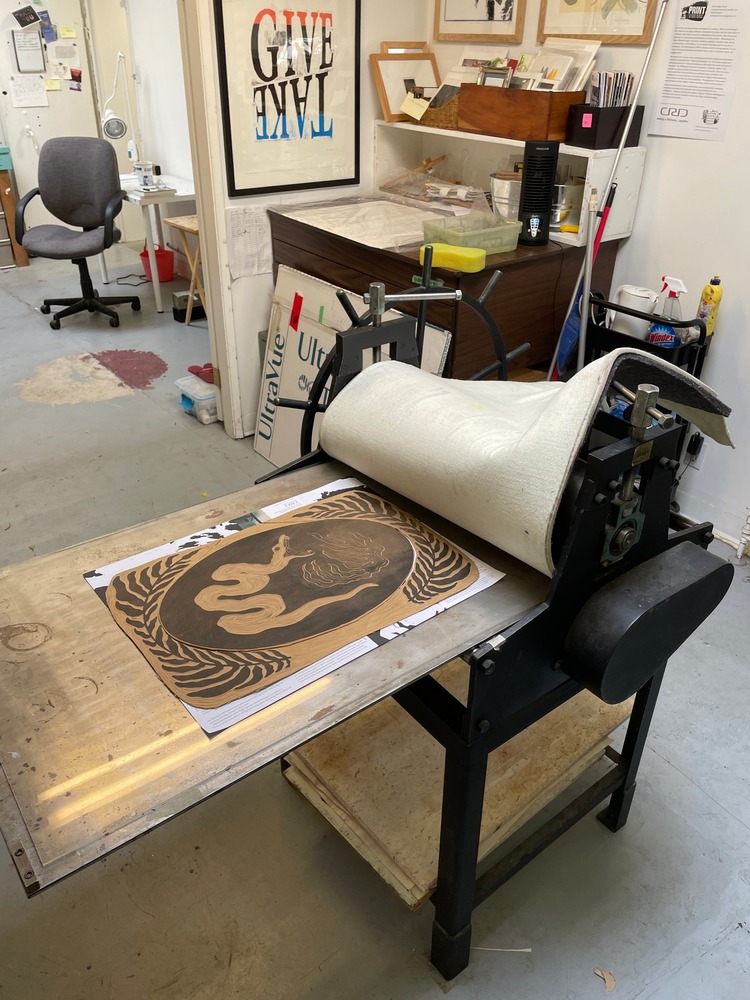
 Currently, inspiration for Austin’s works comes from masters including Kawarazaki Shodo, Utagawa Kunisada, and Utagawa Kuniyoshi, to name a few. “I consider my art to fall into the genre of Ukiyo-e,” says the printmaker. Austin still works with lino, but has also began making woodblock prints, with an aim to focus more on this practice as he continues to move forward with his artistic endeavours. He comments; “I have found carving wood allows me to pay much more attention to detail, and I enjoy building multi-layered composite images with water-based pigments. I also find that working with wood allows me to have a more sustainable practice.”
Currently, inspiration for Austin’s works comes from masters including Kawarazaki Shodo, Utagawa Kunisada, and Utagawa Kuniyoshi, to name a few. “I consider my art to fall into the genre of Ukiyo-e,” says the printmaker. Austin still works with lino, but has also began making woodblock prints, with an aim to focus more on this practice as he continues to move forward with his artistic endeavours. He comments; “I have found carving wood allows me to pay much more attention to detail, and I enjoy building multi-layered composite images with water-based pigments. I also find that working with wood allows me to have a more sustainable practice.”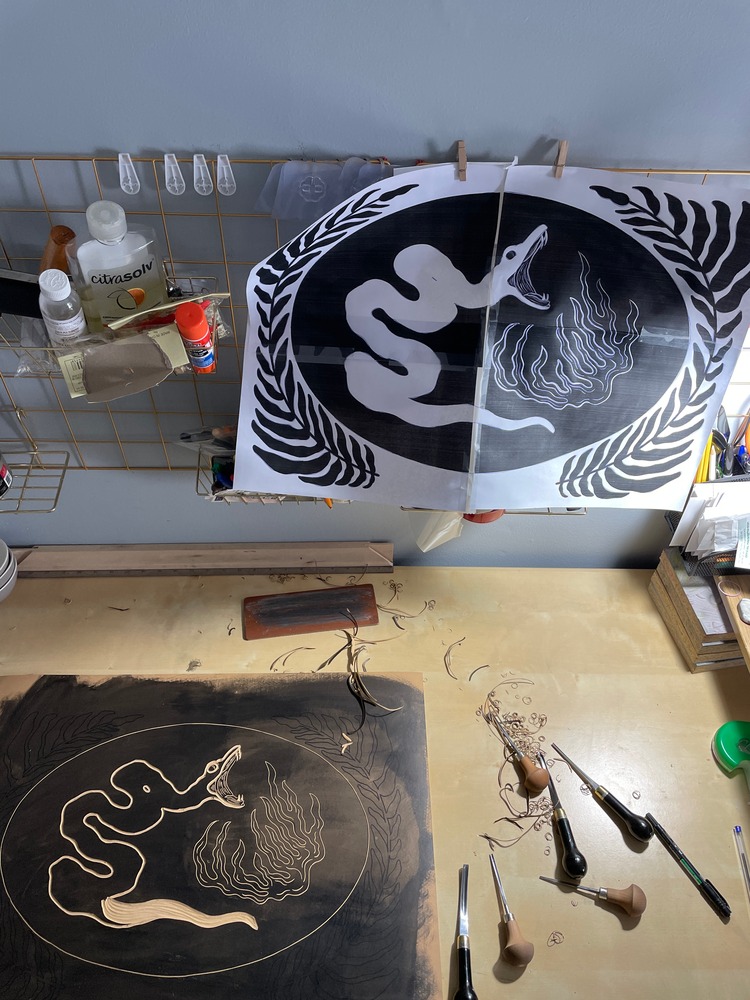
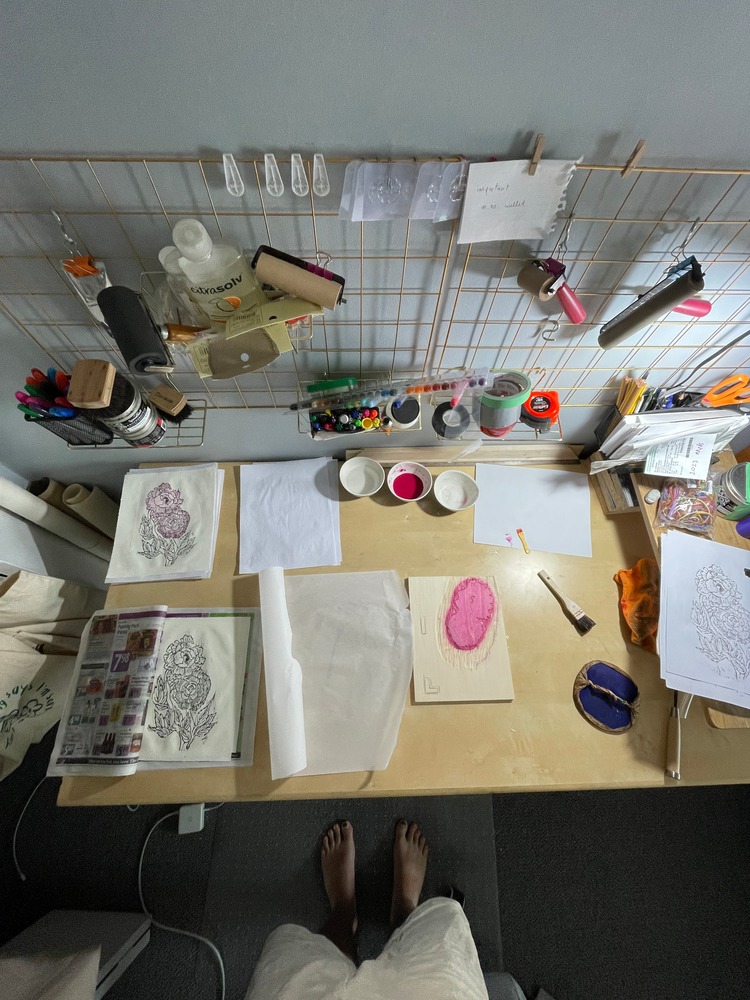
 Austin has become involved in the local artistic community participating in local events and workshops, as well as promoting creative reuse initiatives to divert materials from the landfill. In the long term, he hopes to begin making more larger commissioned pieces as opposed to editioned prints.
Austin has become involved in the local artistic community participating in local events and workshops, as well as promoting creative reuse initiatives to divert materials from the landfill. In the long term, he hopes to begin making more larger commissioned pieces as opposed to editioned prints.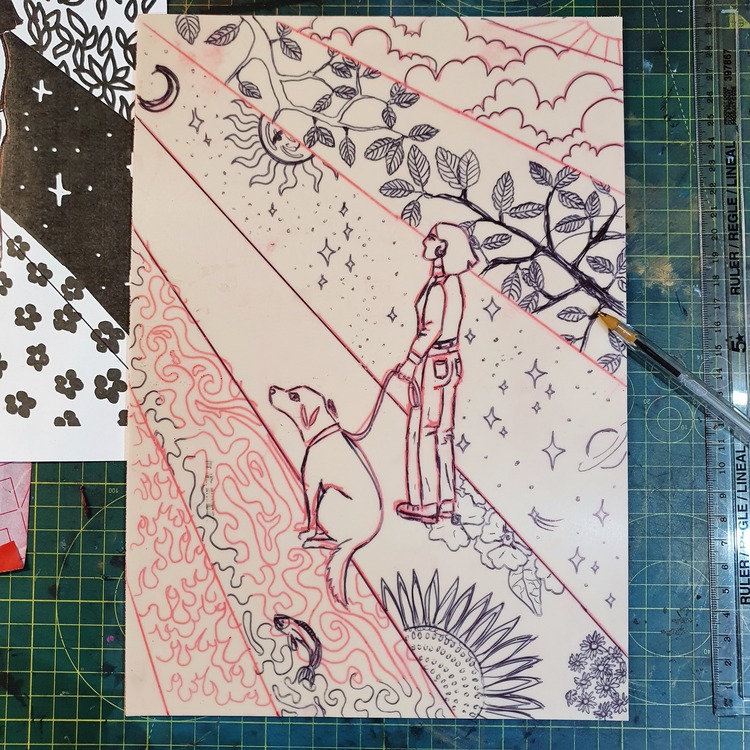
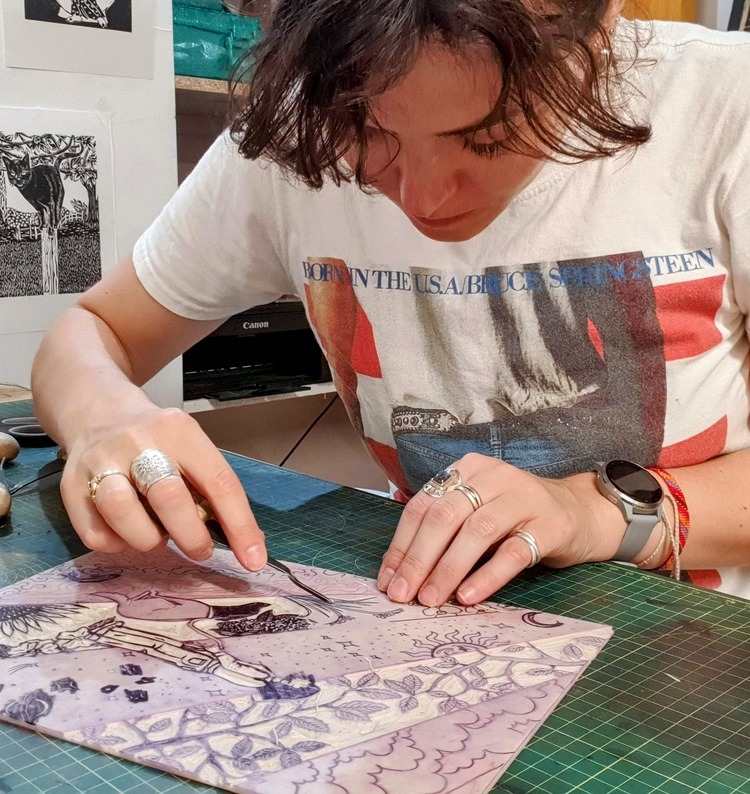 Rosanna’s artistic process involves a lot of doodling, and then using Procreate to get the right image, and carbon paper to transfer the image to the soft cut Lino block. “Carving the block might be my favourite part, I like to get lost in the process,” describes Rosanna. This print took the most amount of time of any of her prints thus far, resulting in a strong, clean, and detailed appearance. Going for a Walk is printed onto Japanese Hosho paper using Caligo Safe Wash in.
Rosanna’s artistic process involves a lot of doodling, and then using Procreate to get the right image, and carbon paper to transfer the image to the soft cut Lino block. “Carving the block might be my favourite part, I like to get lost in the process,” describes Rosanna. This print took the most amount of time of any of her prints thus far, resulting in a strong, clean, and detailed appearance. Going for a Walk is printed onto Japanese Hosho paper using Caligo Safe Wash in.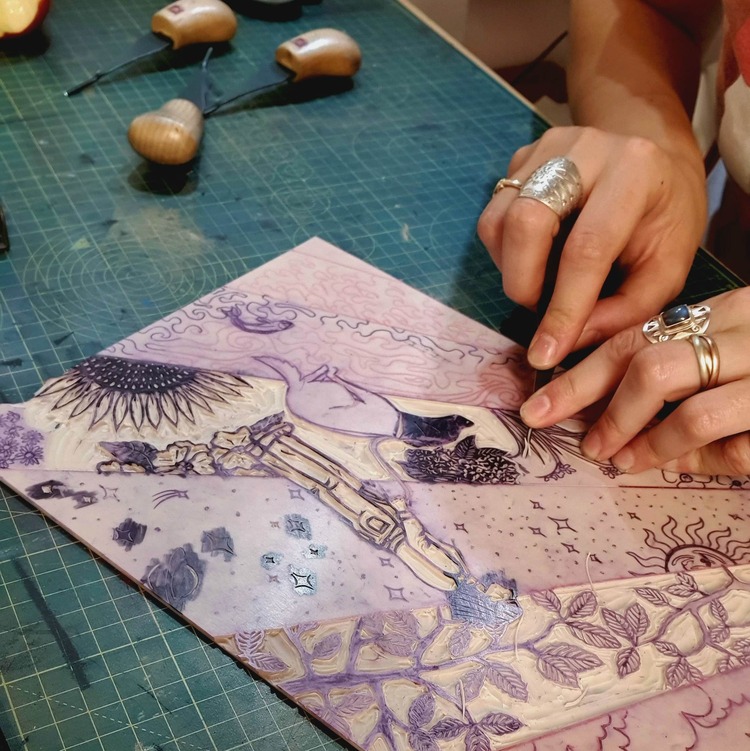
 Rosanna concludes; “I’m really pleased with how it turned out, and I particularly like the waterfall section. One of my biggest inspirations is comic books and graphic novels, and I like to imagine this print could be a spread page of a comic… maybe one day!”
Rosanna concludes; “I’m really pleased with how it turned out, and I particularly like the waterfall section. One of my biggest inspirations is comic books and graphic novels, and I like to imagine this print could be a spread page of a comic… maybe one day!” RSS Feed
RSS Feed
